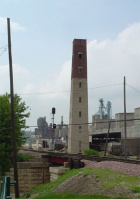Shot tower
A shot tower is a tower designed for the production of shot balls by freefall of molten lead, which is then caught in a water basin. The shot is used for projectiles in firearms.
Contents[hide] |
[edit] Shot making
[edit] Process
In a shot tower, lead is heated until molten, then dropped through a copper sieve high up in the tower. The liquid lead solidifies as it falls and by surface tension forms tiny spherical balls. The partially cooled balls are caught at the floor of the tower in a water-filled basin.[1] The now fully cooled balls are checked for roundness and sorted by size; those that are "out of round" are remelted. A slightly inclined table is used for checking roundness.[2] To make larger shot sizes, a copper sieve with larger holes is used. However, the maximum size is limited by the height of the tower, because larger shot sizes must fall farther to cool. A polishing with a slight amount of graphite is necessary for lubrication and to prevent oxidation.
[edit] History
The process was invented by William Watts of Bristol, England, and patented in the late 18th century.[1] Watts extended his house in Redcliffe, Bristol to build the first shot tower in 1782.[3] Shot towers replaced the earlier techniques of casting shot in molds, which was expensive, or of dripping molten lead into water barrels, which produced insufficiently spherical balls. Large shot which could not be made by the shot tower were made by tumbling pieces of cut lead sheet in a barrel until round.[4] Shot towers were replaced by the "wind tower" method by the end of the 19th century, which used a blast of cold air to dramatically shorten the drop necessary.[5] Today the Bliemeister method is used to make smaller shot sizes, and larger sizes are made by the cold swaging process of feeding calibrated lengths of wire into hemispherical dies and stamping them into spheres.[6]
[edit] Examples
The tallest shot tower ever built in Australia still stands in the Melbourne, Australia suburb of Clifton Hill. This brick structure was built in 1882 and is 160' (49 m) high.[7]
Another notable shot tower is the Jackson Ferry Shot Tower, located in Wythe County, Virginia, whose construction began around 1800 in a rural area. It was built of stone with walls almost a meter (2.5 feet) thick, as it was not practical to use brick in that region for such a large structure. The 23 meter (75 foot) tower was built at the edge of a cliff and utilized a subterranean shaft of the same length to double the overall height the lead would drop.
There was a prominent Shot Tower on the South Bank of the River Thames in central London, England. It was constructed in 1826, and was in use until 1949, but was demolished to make way for the Queen Elizabeth Hall (opened in 1967), after being retained as a feature in the 1951 Festival of Britain. Another square shot tower was also located not far away downstream along the Thames.
Other surviving examples of shot towers include:
- Cheese Lane Shot Tower, Bristol, UK - now part of an office development called 'Vertigo' - this was the reinforced concrete tower built to replace the very first shot tower built in Redcliffe by William Watts;[3]
- Chester Shot Tower, Boughton, UK - circular brick tower, built in 1799; the oldest surviving shot tower in the UK[8]
- Clifton Hill Shot Tower, Melbourne, Australia
- Coops Shot Tower, Melbourne, Australia
- Crane Park Shot Tower, Twickenham, UK
- Drochtersen Shot Tower, Drochtersen, Germany
- Helena Shot Tower, Spring Green, Wisconsin, USA[9] - built in 1831, now part of a state park.
- Dubuque Shot Tower, Dubuque, Iowa, USA
- New Vienna Shot Tower, New Vienna, Iowa USA
- Jackson Ferry Shot Tower in Wythe County, Virginia, USA - built in the 1790s, now part of a state park and open to the public during the tourist season.
- Peters Shot Tower, Kings Mills, Ohio, USA
- Pispala Shot Tower, Pispala, Tampere, Finland
- Rossie Shot Tower, Rossie, New York, USA
- Phoenix Shot Tower at Baltimore, Maryland, USA
- George W. Rogers Company Shot Tower, Dubuque, IA, listed on the NRHP in Iowa
- Shot Tower (Max Meadows, Virginia), listed on the NRHP in Virginia
- Shot Tower (Spring Green, Wisconsin), listed on the NRHP in Wisconsin
- Remington Shot Tower, Bridgeport, Connecticut, USA
- Sparks Shot Tower, Philadelphia, Pennsylvania, USA - built in 1808
- Taroona Shot Tower. Hobart, Australia
- Winchester Shot Tower, New Haven, Connecticut, USA
- CAC Shot Tower, Mt Eden, Auckland, New Zealand[10]
[edit] References
- ↑ 1.0 1.1 No. 422: Shot Tower
- ↑ Re: How the small lead shot ( 7 - 8 sizes ) used for shotgun shells are made?
- ↑ 3.0 3.1 Images of England: Sheldon Bush and Patent Shot Company Limited, Cheese Lane, Bristol
- ↑ The Age 150th
- ↑ History of the American Shot Tower
- ↑ The romance of lead shot - Shotgunner | Guns Magazine | Find Articles at BNET.com
- ↑ http://vhd.heritage.vic.gov.au/vhd/heritagevic#detail_places;295
- ↑ Images of England: Chester Leadworks and Shot Tower
- ↑ Tower Hill State Park Shot Tower
- ↑ "Colonial Ammunition Company Shot Tower". Register of Historic Places, New Zealand Historic Places Trust.
[edit] External Links
- "Gravity Molds Shot In A Modern Tower", October 1944, Popular Science detailed and large article on subject of Shot Towers


